
We have previously written about SikhLens, an art and film festival which brings together Sikh filmmakers, authors, artists and actors. For those of you who support the development of Sikh arts, you will be pleased to know that the second annual Sikh Art and Film Festival (SAFF) will be held from November 19th-21st, 2010 at the Dodge College of Film and Media Arts at Chapman University in Orange, CA. SAFF provides a venue for artists to present their “Sikh-centric” films, art, and music to the broader community with the intent of showcasing their talents and generating increased Sikh awareness.
The Festival begins Friday, November 19th with a red-carpet Opening Night starting at 7:30 pm. A youth-focused cluster will start off the Saturday events. This cluster focuses on films and live book readings intended to incite interest and inspire youth, while teaching about Sikh history. The focus then turns to creative Sikhs in the Visual, Audio and Entertainment Industries. Hear their stories, watch and listen to their craft, and interact with and support Sikhs breaking ground in these unique areas. Also introducing for the first time an interactive segment on “Introduction to Film-making,”to demystify the film-making process. Rounding out the day’s events are a series of short films featuring a wide variety of genres, an eclectic mix of filmmakers, and a unique blend of topics, including special selections from the SikhNet Youth Online Film Festival. Sunday’s events start with an international flavor, with an emphasis on Sikh films and artists from all over the world. The concluding cluster of the festival will touch upon Social Issues within the Sikh Diaspora. This segment is aimed to bring upon a meaningful and insightful look into the surroundings of the Sikh Community today.
I am especially interested in this final cluster which brings together films addressing the social issues that inflict our community. We have spoken many times on this blog about how media and film are critical to dialoguing about important issues.
 This weekend Sikhlens will be presenting its annual Sikh Art and Film Festival 2009. The film festival showcases the best in Sikh movie-making talents from around the globe. It also presents a forum for aspiring Sikh artists to also come and display their burgeoning talents. A few book launches are planned with a particular emphasis on children’s books. Authors of A Lion’s Mane and The Royal Falcon are planned to be in attendance to do a live reading.
This weekend Sikhlens will be presenting its annual Sikh Art and Film Festival 2009. The film festival showcases the best in Sikh movie-making talents from around the globe. It also presents a forum for aspiring Sikh artists to also come and display their burgeoning talents. A few book launches are planned with a particular emphasis on children’s books. Authors of A Lion’s Mane and The Royal Falcon are planned to be in attendance to do a live reading.
The inaugural Sikh Art and Film Festival will be held at the historic Egyptian Theatre in Hollywood, CA on November 13-15th.
In previous articles on The Langar Hall, I have written about how certain Sikh-film haters groan in jealousy and spew hatred, about the Sikhs’ taking advantage of new forms of media. Such efforts in the community should be encouraged and more platforms created.
The weekend features a number of different clusters, highlighting issues on the youth, creative Sikhs, short films, feature films, and even Remembering 1984. The Remembering 1984 cluster on Sunday afternoon will be co-hosted with the Jakara Movement in conjunction with it’s Visions of Truth film series.
So whether you come for the entire weekend, make it out to just one cluster (at $15 pre-sale, you won’t find a better price), or at least to Sunday’s mela, check the schedule, check out the films, and make sure you come out and support Sikh arts! We’ll be in attendance and will post on our experience after the event.
East coasters and others with expendable income: the Sikh Art & Film Foundation is bringing you the 2009 International Film Festival to be held at the Asia Society and Museum.
The Festival will kick off on Friday September 18th with 3 films (My Mother India, Flying Sikhs – A History of Sikh Fighter Pilots, and Nineteen Eighty-Four and the Via Dolorosa Project). The night ends with a party at Asia Society’s Garden Court. The Festival continues on Saturday with 4 documentaries (A Warrior’s Religion
Not Every Time…, Turbanology, Who Do You Think You Are – Meera Syal) and 6 short films (Battle of Chillianwala – The Waterloo of India, Bhangra Generation, Prisoner’s Song, Street Smarts, turBAN, and
Unravelling). Saturday concludes with the Heritage Gala After Party at Leela Lounge. Mira Nair will be honored and $15,000 in cash will be awarded to filmmakers.
A pass to all above events is only $45. Buy your tickets before they sell out!
BREAKING NEWS: The Sikh Art and Film Foundation has responded by including a female speaker in next week’s Leadership Summit!!! Great progress. Â Yet, the lack of representation of women and girls from 2004 – 2012 in the film festivals and galas still needs to be addressed, and this is a community wide issue. Â See below for actionable solutions.
Via Email:
November 15, 2013 7:43PM Nina Chanpreet Kaur,
Dear Sikh Art and Film Foundation,
I am very glad to see that Rashmy Chatterjee will be speaking at next Friday’s Leadership Summit.  This is a tremendous gain for our community as most of the speakers at the summit have been men since 2011.  This represents a trend in many Sikh organizations I hope we can change together. As a Sikh woman and resident of NYC for the last 11 years, I have followed your organization since it’s inception.  Over the years, I have attended many of your events and have been so inspired by the films, speakers and attendees.  I have also noticed the lack of representation of women and girls in your programs.  Though you took a step forward this week, I believe you could be doing more to address, highlight and celebrate the challenges and triumphs of Sikh women and girls whether in your Film Festival, Heritage Gala or Leadership Summit.
I understand that your goal is to transcend the dichotomies and binaries of gender and other categories to sustain the universality and equality that our Gurus envisioned in order to promote and preserve Sikh and Punjabi heritage. Â I share your vision and do not condone a gender binary or bias towards either men or women. Â I am also aware that you face limitations as all organizations do, in particular that you must base the selections of films on the submissions you receive. Â However, Sikh men and boys have been a central part of your programs in a way Sikh women and girls have not and this indicates a bias – whether intentional or not.
From 2007 to 2012, none of your Gala awards for Leadership and Vision have been presented to Sikh women. Â In fact, the only women who received awards were for Creativity/Art with the exception of Shonali Bose who received an award for Courage and Shelley Rubin who received an award for Leadership jointly with her husband. Â For 5 years in a row you have only presented Sikh women with awards for Creativity/Art and no other category. Â As a Sikh woman, this sends a message to me and the next generation of Kaurs that women can be honored for creativity and art but not for leadership and vision. Â It raises questions about your beliefs and assumptions related to gender roles and women’s capacities in relation to men. Â This is most certainly not the message young Kaurs should be receiving, nor do I think this is your intention based on the email I received from Ravi last week. Â Â Â Â Continue Reading »
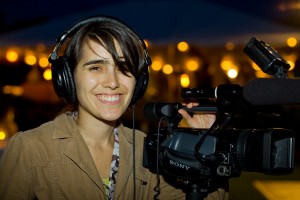
Christina Antonakos-Wallace, filmmaker of with WINGS and ROOTS
Christina Antonakos-Wallace is the filmmaker behind with WINGS and ROOTS, a 90-minute documentary that tells the stories of five people from different immigrant communities living in New York or Berlin, Germany, who have struggled to shape their identity in various ways.
The film features The Langar Hall’s own Sonny Singh, a Sikh living in New York. Part of his story was featured in the well-received short documentary Article of Faith, spawned from the with WINGS and ROOTS project, that portrays Sonny’s activism around bullying of Sikh school children in New York. Another short film, called Where are you from from? was also produced out of this project.
Below, Christina Antonakos-Wallace discusses the film and provides great insight about its intended message regarding the immigrant experience and the search for identity. You can view the trailer for with WINGS and ROOTS at the end of this post.
It’s that time of year again!
For those Southern California natives, you (hopefully) know it rolls around once every year. This year, SikhLens is proud to announce its annual Sikh Arts and Film Festival to be held November 18th – 20th, 2011 at the prestigious Dodge College of Film and Media Arts at Chapman University in Orange, California. As avid supporters of Sikh Arts, and creativity in general, I am hoping our readers would be especially interested in this event coming up in the next couple of weeks.

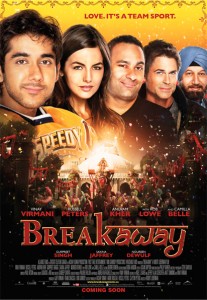 The Sikh Arts and Film Festival serves as a central venue for artists to showcase and share Sikh heritage and culturethrough the mediums of film, literature, art, music, social media and fashion. As an often-misidentified minority, this type of forum has proven to be essential for Sikhs to transcend cultural boundaries, generate awareness, and connect with the broader community.
The Sikh Arts and Film Festival serves as a central venue for artists to showcase and share Sikh heritage and culturethrough the mediums of film, literature, art, music, social media and fashion. As an often-misidentified minority, this type of forum has proven to be essential for Sikhs to transcend cultural boundaries, generate awareness, and connect with the broader community.
For tickets, scheduling and more information, visit www.sikhlens.com.
On many occasions, I have noted my dismay at the joke of journalism that calls itself the Times of India. They never cease to provide stupid nonsensical and ill-researched articles. Here is one more example.
It appears that the writer ‘Divya A’ has recently been making his/her rounds at various Sikh film screenings and festivals. Instead of lauding a young community on its tenacity to promote arts and encourage creativity in the community, the author can only wonder:
But how healthy is it for a community to focus on a painful past and present itself to the world as a suffering and wronged people?[link]
Who is the author to decide what is right or wrong for the community?
The author continues to push a nonsensical ‘Khalistani’ conspiracy theory as the raison d’etre behind the shift to visual arts. Instead of looking at the broader context of the proliferation of youtube with film and television being the visual media of the masses, the author believes there is something far more sinister.
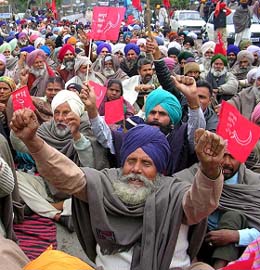 While I do value the role films play in telling stories, I wonder if at times it can do more harm than good. I recently heard about a new bollywood movie called Kisaan and had the opportunity to watch it last night. I had been told the movie was about farmer suicides in punjab and while i was aware it was a bollywood production, I definitely made time to watch it as it is such an important issue.
While I do value the role films play in telling stories, I wonder if at times it can do more harm than good. I recently heard about a new bollywood movie called Kisaan and had the opportunity to watch it last night. I had been told the movie was about farmer suicides in punjab and while i was aware it was a bollywood production, I definitely made time to watch it as it is such an important issue.
The movie touched upon issues such as the role illiteracy and dowry play in the lives of farmers – the reality of poverty overpowered by the hope of prosperity. These are important issues and should be discussed. Films are an important tool to utilize in order to raise awareness about such issues.
Suffice it to say, Kisaan is a bollywood production and is distracted by it’s commitment to bollywood requirements. I can’t say i wasn’t disappointed – this is such an important issue which needs to be explored. While i commend the director for attempting to raise the issue, i do question if this genre of film was the best vehicle for it. The issue was so entangled in the film, mixed in with songs and awkward jokes, that i can’t imagine how serious the issue will be taken.
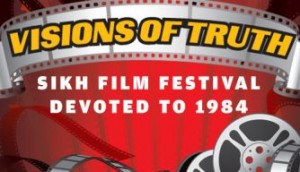 Last week, Reema discussed the dynamic Punjabi-Sikh art scene. We’ve come a long way, especially in the field of film and media with a growing number of films by, for and about Sikhs. Now, you can attend Sikh film festivals in every corner of the country and even internationally. In addition to this, Sikhnet recently announced it’s 2009 Youth Online Film Festival. This online film festival is especially significant as it offers young inspired Sikhs an opportunity to showcase their creativity on a positive platform. Films such as turBAN, a film by Dashmesh Pictures and G.N.E., provides an “artistic editorial challenging current regulations invoked in the French public school system.” Each film plays an important role in portraying Sikh stories in creative ways.
Last week, Reema discussed the dynamic Punjabi-Sikh art scene. We’ve come a long way, especially in the field of film and media with a growing number of films by, for and about Sikhs. Now, you can attend Sikh film festivals in every corner of the country and even internationally. In addition to this, Sikhnet recently announced it’s 2009 Youth Online Film Festival. This online film festival is especially significant as it offers young inspired Sikhs an opportunity to showcase their creativity on a positive platform. Films such as turBAN, a film by Dashmesh Pictures and G.N.E., provides an “artistic editorial challenging current regulations invoked in the French public school system.” Each film plays an important role in portraying Sikh stories in creative ways.
Another notable film-related event is Visions of Truth, a traveling film festival devoted to showcasing films about 1984. The film festival will be held during the months of September and October in eight regions in California including: Yuba City, Sacramento, San Jose, Fresno, Los Angeles, Irvine, Riverside and San Diego.
The goal of “Visions of Truth” is to spur dialogue between members of the community by showcasing film and music media related to the third Sikh holocaust (1984). This event remains one the most significant, events in the history of Sikhs. In early June 1984 the Indian Army invaded one of the most historic of all Sikh Gurdwaras, the Darbar Sahib complex in Amritsar, Punjab. The ensuing destruction and loss of life marked one of the darkest chapters of the later 20th century for Sikhs. The aim of the film festival is not only to remember the events of 1984 but also to raise awareness in the community and promote positive dialogue. [link]
I was excited to come across information about the Jaipur Literature Festival which will be held January 21st through the 25th in Rajasthan (mainly excited because it will coincide with a trip I’m planning to take to the area!). The festival is directed by author and historian, William Dalrymple.
Entering its fourth year, the festival will be hosting some of the best-known national and international writers including Vikram Seth, Michael Ondaatje, Pico Iyer, Simon Schama, Colin Thubron, Patrick French, Tariq Ali, Tina Brown, Mohammed Hanif, Rajiv Chandrasekaran, Coleman Barks, Pankaj Mishra, Chetan Bhagat, Ahmed Rashid, Charles Nicholl, Hari Kunzru, Michael Wood, Nandan Nilkeni, Paul Zacharia, Prasoon Joshi, Shashi Tharoor, Sunil Gangopadhyay, Tarun Tejpal, Wendy Doniger, U R Ananthamurthy, among many others.
While perusing through their list of authors, I was surprised by the small number of Sikh writers who will be in attendance leading me to ask which (if any) other Sikh authors were invited and whether Sikh authors were, in general, being recognized for their work. While we attempt to address these questions, I wanted to use this space to highlight a couple of Sikh authors who did show up on the list.
Heads-up friends, the season of the “Spinning Wheel Festival” is about to begin across North America this autumn. Celebrating Sikh films and art, the first stop will be in New York City on Saturday, October 04, 2008 at the Asia Society & Museum (p.s. that’s next Saturday). Buy your tickets NOW! The wonderful Rabbi Shergill will be performing at the opening gala (yes I am really biased here … I heart Rabbi Shergill) and DJ Rekha will be literally “spinning” at the after party.
Films a the NYC festival will range from documentaries on Pahelwani (i.e. Panjabi wrestling) and Kaba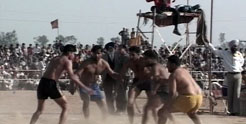 ddi-playing Canadian police officers to issues affecting the Sikh community from 1984 and post-9/11 hate crimes. There will also be short and feature films. For example, one on a young boy’
ddi-playing Canadian police officers to issues affecting the Sikh community from 1984 and post-9/11 hate crimes. There will also be short and feature films. For example, one on a young boy’ s struggle to keep his hair while his family fears the obstacles he will encounter and another on “… a young Sikh doctor struggling with the inequities of the American Health System and ultimately his own identity”. The Holy Duels of Hola Mohalla is a film looking at the Khalsa Panth.
s struggle to keep his hair while his family fears the obstacles he will encounter and another on “… a young Sikh doctor struggling with the inequities of the American Health System and ultimately his own identity”. The Holy Duels of Hola Mohalla is a film looking at the Khalsa Panth.
The films seem interesting both in content and presentation. The stories are grounded in the realities many of us encounter everyday. You can get a full listing of the films and their synopses here.
In the past, I have attended the “Spinning Wheel Festival” at one of its many North American stops and found it a great space for artists and art-enthusiasts to be exposed to Sikh creativity. I remember there being a panel discussion with the directors and the audience. We don’t have too many of these creative opportunities in our community even though we spend plenty of time and space advertising foreign medical schools in Poland, China, and the Caribbean.
I have found that some films are really hit or miss at these festivals, but it’s expected sense the focus is on cultivating and inspiring creativity; while, building a permanent Sikh film festival for years to come. Cash prizes are awarded to the “bests” in various categories. I have been told that the listing and quality of films varies across the different North American stops.
At the end of the day why not go, especially if it’s close by. I personally think it’s worth a visit as an act of supporting Sikh arts and learning about the various issues affecting our community. Sometimes we get too caught up in our own worlds and don’t realize these issues are taking place or we are in amidst of them and they become normal parts of our lives leaving very little room for reflection or exposure to others’ perceptions. Thus, it’s an 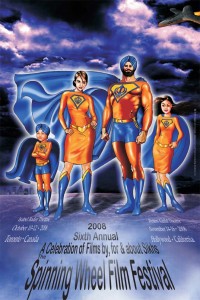 opportunity to get a fresh/new look at various issues.
opportunity to get a fresh/new look at various issues.
Lastly, the arts, from painting and photography to films and music, are our community’s soul! They help us speak in ways we can’t always articulate. So go save your soul and attend a Sikh artistic event! 
Okay, enough of the attempt at convincing … the other North American stops will be:
- Toronto, Canada from October 10-12, 2008 at the Isabel Bader Theatre.
- Hollywood, California from November 14-16, 2008 at the Writers Guild Theatre.
Are ya’ll thinking of going? What have your experiences been at the various Spinning Wheel Festivals? Does anyone know of other North American stops?
p.p.s. The Toronto and Hollywood poster is really interesting isn’t it … a conversation in of itself!
While the young Sikh filmmakers are probably preparing for the annual Sikhnet Youth Film Festival (have you seen their ad on satellite television, it is very impressive!), I recently came across some internet announcements for a list of fascinating Canadian-produced short films that I hope will galvanize future discussions.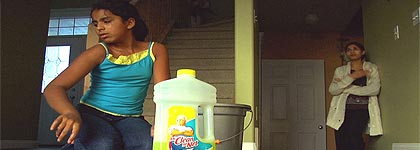
Although I must confess, at this point, I have NOT seen any of them, still, I wanted to highlight them and hear back from the Langa(r)eaders about their thoughts. Hopefully some of our more vocal Canadian Langa(r)eaders will give us first voice about the films: P.Singh, yes even kaptaan, and others.
Me, Masi, and Mr. Clean
The description from the film’s website is quite poignant:
Eleven year old Seema has issues with her skin colour. Surrounded by the white kids of her community, and inundated by her masi’s (aunt) opinion that fair skin is better, Seema resorts to drastic measures to bleach her skin.
Seema mistakenly believed that using Mr. Clean on her skin will lead to a fairer, more beautiful colour. When Seema ends up in the hospital an unsuspecting character helps her understand skin colour isn’t what defines the person – it’s what’s beneath that counts[link]
Shonali Bose, writer and director of the acclaimed 2005 film Amu (which powerfully uncovered the brutal realities of 1984) has just 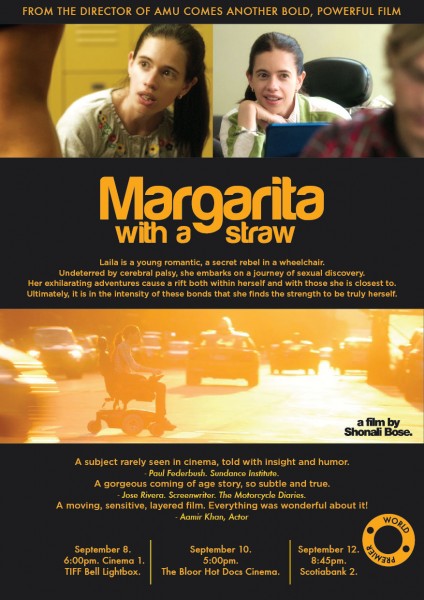 completed a new feature film called Margarita, with a Straw. Premiering next week at the Toronto International Film Festival, the film is a coming of age love story about a part-Sikh college student from Delhi named Laila who has cerebral palsy.
completed a new feature film called Margarita, with a Straw. Premiering next week at the Toronto International Film Festival, the film is a coming of age love story about a part-Sikh college student from Delhi named Laila who has cerebral palsy.
Given the popularity of Amu in the Sikh community, I wanted to interview Shonali about her new film, which explores equally important issues to those brought up in Amu—disability and sexuality among them. Read on for the full interview, and check out the trailer here.
What inspired you to make Margarita, with a Straw?
This my second film, which is inspired by my cousin sister Malini who has acute cerebral palsy. That’s a condition where the part of your brain that controls your motor skills is damaged at birth. But your emotional and intellectual abilities are intact. When I was 40 and Malini was 39, I asked her, what are we going to do for your 40th? It’s absolutely the best birthday. Her speech is usually garbled and difficult to understand. But sometimes when she is angry or excited – it comes out crystal clear. This was one of those times. She banged her fist on the table and spoke loud and clear: I just want to have sex by the time I’m 40! I grinned sheepishly and assured her it was not what it was made out to be, etc. But later when I was thinking about what she said, what she so passionately wanted – I realized that I had never thought about her sexuality much. Or maybe I just avoided it as I didn’t know what to do about it. This started me on my journey of Margarita.
As I started exploring my fictional character and her issues, the big question that came up was one of self worth. This is a core issue that everyone faces, whether one is disabled or not. From there it went to a place of finding deep self acceptance and self love.
I loved your first film, Amu, which powerfully highlighted the anti-Sikh pograms of 1984 through the eyes of a young Sikh woman. The main character in your new film is also a Sikh woman. Where does your interest in telling “Sikh stories” come from?
I don’t see them as Sikh stories at all. The 1984 genocide is a watershed in the entire subcontinent. Like Partition. I made a film about it because no one had and it was covered up. And this history had to get out. To me, this is not a Sikh issue. It’s an Indian issue. Thousands of innocent people being killed in the capital city in broad daylight, organized by those in power—30 years later justice still not delivered. Every justice loving Indian—every Indian who cares about right and wrong and about their country—should be as bothered by this issue as those who were made victims. That was the aim of Amu. In fact, the leads are all Bengalis. It’s only in the end that the lead protagonist, raised as a Hindu Bengali, finds out that she is Sikh and wears a kara.
When I was making Amu, the son of one of my investors—Bhajneet Singh Malik—told me that he was bothered by the fact that Sikhs are only shown as victims, terrorists, or buffoons in films. That remark stayed with me. It’s a fact. When I started creating characters for Margarita and was thinking of the father’s role, I thought it would be nice if I made him Sikh. As a tribute to Amu. To the community that has given me so much love and support on my first film. Balraj Kapoor is an ordinary middle class father. He also happens to be Sikh. He had a love marriage and married his college mate who is Maharashtrian. The actor playing this role was actually little Amu’s father who got killed in Amu.
Bhajneet also said that he hated when Sikhs were played by non-Sikhs who put a turban on. So it was very important to me once I made this decision to cast a real Sikh. My lead protagonist in Margarita is the daughter of this man, Laila Kapoor. She is half Punjabi, half Maharashtrian. Half Hindu. Half Sikh.
The Best:
-
Bhai Gurbaksh Singh went on a hunger strike for 44 days which led to the release of 4 political prisoners and increased international attention on human rights in India. We were all deeply moved and inspired, and Bhai Sahib sparked a new movement!
-
Sikh women claimed their place in new and outstanding ways!
-
Balpreet Kaur gave this inspiring talk. We all love her.
-
SAFAR held it’s second annual Young Women’s Leadership conference, took us beyond International Women’s Day and shared a beautiful message on the International Day of the Girl.
-
The Sikh Coalition acknowledged International Day of the Girl for the first time.
-
The Sikh Activist Network featured poems about rape in India.
-
Sikhnet hosted an online youth film festival focused on KAUR. How amazing is that?!
-
The Sikh Art & Film Festival added a female speaker to their panel and 18MillionRising stepped in to support gender equality.
-
My awesome friends are building a Dastaar Tutorial Project for women (more details to come soon). Maybe now I can figure out how to keep a patka on my head that doesn’t slip off underneath my dastaar. Win!!!!!
-
-
We marked the one-year anniversary since Oak Creek and grieved several other hate crimes but still came out on top.
-
Piara Singh was attacked in Fresno and the community rose to the occasion in inspiring ways, serving meals and buckets full of compassion to local families.
-
Dr. Prabhjot Singh invited his attackers to worship with him and shifted the narrative of justice when it comes to hate crimes.
-
The Sikh Coalition released a new version of Fly Rights. Rockin it!
-
Jasjeet Singh spoke at the 50th Anniversary of the March on Washington. No big deal.
-
Dr. Kiran Arora began a study on religion and race-related stress among North American Sikhs. Much-needed.
-
Turban Myths was released, the first national public perception assessment on the Sikh American community, conducted by SALDEF in collaboration with Stanford University. Nicely done! Continue Reading »
-
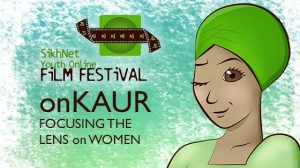 There are only a few days left in the annual SikhNet Youth Online Film Festival. Â This year’s theme, “onKaur: Focusing the Lens on Women”, brings together a collection of 18 films by and about Sikh women. Â The films look at the idea of “Kaur”, what that means and how it can be represented in film.
There are only a few days left in the annual SikhNet Youth Online Film Festival. Â This year’s theme, “onKaur: Focusing the Lens on Women”, brings together a collection of 18 films by and about Sikh women. Â The films look at the idea of “Kaur”, what that means and how it can be represented in film.
The films have been categorized as documentary (“think”) and drama (“cry”) with issues including: Anand Karaj, bullying, hair, health issues of Panjab, gender justice, family, and gatka among others.
The film festival is important for several reasons and this year’s theme brings to light the need to include Sikh women’s voices in conversations around identity and community. Â It’s a valuable way of showcasing issues affecting Sikh women.
Here’s how to view and vote:
The film festival also provides a platform for young filmmakers to showcase their films to a wider audience.
1. View the documentary films here and vote via Facebook.
2. View the drama films here and vote via Facebook.
Voting ends on October 9th.
As a community, we have an incredibly rich history and yet we often know so little about it. The first time I learned about the Sikligar community was after watching Mandeep Sethi’s documentary at a local film festival, about this community of Sikhs known to be the weapon makers of the Khalsa army. Unfortunately, very little is known about the Sikligars by those living both within and outside of India and Mandeep’s film will be a first glimpse into the community for many. The Sikligars are found across India – displaced through years of colonization and government oppression. It is known that the community was given the name Sikligar by the 10th Guru of the Sikhs, Guru Gobind Singh Ji and yet even this honor has not prevented the community from struggling – Sikligars now live in extreme poverty in the slums of Rajasthan, Delhi and Agra. There are also encampments in Punjab. Although this community has been largely illiterate for the last 300 years (focusing on their trade and thus livelihood), the Sikligars are beginning to empower themselves through different means such as education. For the first time, the full length documentary is available online! Over the past few months, I’ve joined Mandeep at several film screenings of his documentary and I’ve asked him some questions about SIKLIGAR which you can find after the jump.
Guest blogged by Nina Chanpreet Kaur
August 5th, 2012. 1:33pm. A text message from my best friend: “hostage situation at sikh temple in wisconsin. on al jazeera right now.” We pulled over and exchanged glances, holding our breath it wasn’t an attack perpetrated by someone within the Sikh community. Earlier that morning we rowed in unison, kayaking down the Hudson. Her voice coaching my every movement. Later, riding side by side, we biked to the tennis courts. The wind blowing in our faces and trailing behind our backs, sheer joy and pleasure breezed through me. We had been riding our bikes home when we pulled over. After we said our goodbyes and went our separate ways, I went to hit some tennis balls. The news hadn’t yet sunk in. Once home, my entire being collapsed. I couldn’t avoid the flood of emails, messages and calls. I kept replaying the last few hours. The extreme contrast of the deep pleasure of my morning and the tragedy of Oak Creek felt like some sort of betrayal.
As the shock lifted and the news sunk in, I laid my forehead against the naked floor of my Manhattan apartment and wept. I wept for children, little bare feet hitting cement pavement running for safety. I wept for women crammed into a closet, gunshots threatening to penetrate their bodies. I wept for the pain of separation. I wanted to be there, I wanted to hold each of the bleeding victims in my arms. I wanted to sit next to Wade Michael Page. Make him stop. Have a conversation, maybe a cup of tea. I wept for the memories of the safe gurdwara that cradled me with kirtan as a child. Such a place no longer existed.
News from Wisconsin consumed me. Guilt. Grief. Why wasn’t I there? How does the universe exist in such extremes? At sunset, I picked myself up and started to write. I wrote emails. Long emails. I asked for a vigil. I planned a vigil. I wrote poems. I published them. I lost my appetite and any desire to eat, sleep or cook. I stayed awake through the night to organize. There was no such thing as comfort or rest for me in the weeks following Oak Creek. Heartbroken, the sadness cut through my very center. Organizing was my only way out.
Guest blog by: Rocco
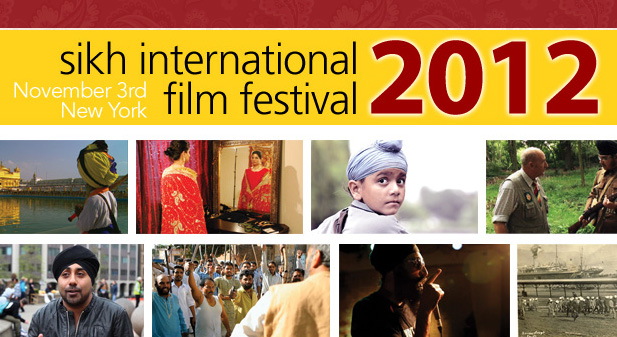 One of the highlights of fall in NYC is the Sikh Arts and Film Festival which showcases the story of our community via films and is being held November 2-3, 2012. Along with that is a Heritage Gala which is being held November 3, 2012 “to celebrate the rich heritage, culture and traditions of the Sikhs.” In the past dignitaries and business leaders have been selected as Chief Guest and Guest of Honors. Unfortunately, The Chief Guest this year is Nirupama Rao, India’s Ambassador to the United States and the Guest of Honors include Prabhu Dayal, Consul General India, New York and Hardeep Puri, India’s Permanent Representative to the United Nations.
One of the highlights of fall in NYC is the Sikh Arts and Film Festival which showcases the story of our community via films and is being held November 2-3, 2012. Along with that is a Heritage Gala which is being held November 3, 2012 “to celebrate the rich heritage, culture and traditions of the Sikhs.” In the past dignitaries and business leaders have been selected as Chief Guest and Guest of Honors. Unfortunately, The Chief Guest this year is Nirupama Rao, India’s Ambassador to the United States and the Guest of Honors include Prabhu Dayal, Consul General India, New York and Hardeep Puri, India’s Permanent Representative to the United Nations.
For some, Sikhs having Indian Government representatives as honorees poses no conflict and should be encouraged. One may argue that the attack on Darbar Sahib and Genocide in 1984 are distant events that occurred twenty eight years ago and should be forgotten. One may argue that the civil war which ensued for ten years afterwards in Panjab and led to the death of the tens of thousands of Sikh youth were collateral damage and justifiable in order to preserve the unity of India. One may argue that that struggle for an independent Panjab has reached its nadir and it’s important to “re-Indianize” ourselves and take advantage of the current economic environment.
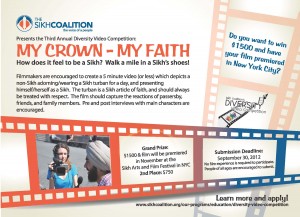 The use of social video sites by our community has seen an upward trend. Of course, many readers of this blog will instantly recognize individuals that have emerged in the last two to three years using YouTube and other social media sites – Mandeep Sethi, Humble the Poet, JusReign, and IISuperwomanII are but a few of the commonly recognized names from North America alone.
The use of social video sites by our community has seen an upward trend. Of course, many readers of this blog will instantly recognize individuals that have emerged in the last two to three years using YouTube and other social media sites – Mandeep Sethi, Humble the Poet, JusReign, and IISuperwomanII are but a few of the commonly recognized names from North America alone.
As it becomes more accessible, we are also seeing the emergence of more grassroots-level use of social video. This medium has allowed Sikhs, and particularly Sikh youth, to express themselves to an unprecedented audience size, and there are several organizations encouraging Sikhs to make use of this platform. For example, SikhNet has been running their Youth Online Film Festival since 2006, and the Sikh Coalition is also holding their third annual Diversity Video Competition for its third consecutive year.
Recently, Manbeena Kaur, the Sikh Coalition’s Education Director, was good enough to answer some questions about the use of social video for the purposes of Sikh education and awareness.
When I met Sonny, I felt that his story demanded to be told. I was moved by his willingness to share difficult stories about how racism, xenophobia, and islamophobia impact him in a very daily and intimate ways. But more importantly, I was inspired by how he had turned this hardship into a motivation to fight for social justice for all people. I was welcomed with incredible warmth, and inspired by the Sikh traditions seeing the divine in all people, and fighting for equality. – Christina Antonakos-Wallace, Producer and Director of Article of Faith
To continue a discussion about bullying and bias-based harassment that seems to be appearing both here on The Langar Hall and also within langar halls across the nation, we wanted to take the time to highlight an inspiring documentary which discusses this very issue. Article of Faith is a short film, directed and produced by Christina Antonakos-Wallace, portraying one Sikh activist, Sonny Singh, who organizes New York City Sikh youth to combat harassment in their schools. Sonny shares his own, very personal experience with bullying recognizing how incredibly important it is for us to openly dialogue about these issues, so that other children who are experience similar challenges do not feel like they are alone.


